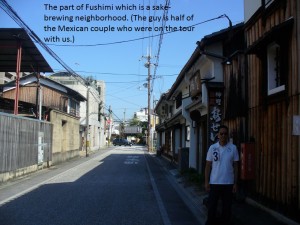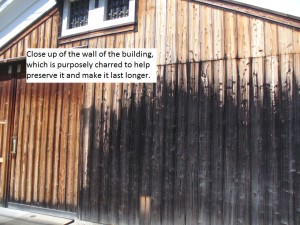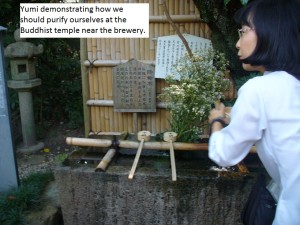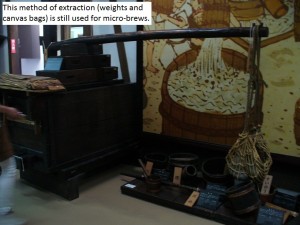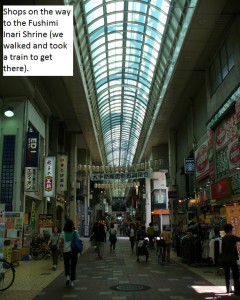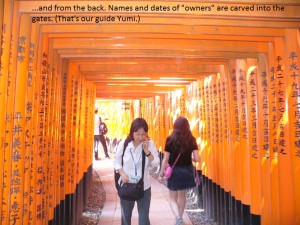
DAY 4
Today was the first day of 3 “organized” day tours I’d signed up for, and this one was to visit the Fushimi Inari Taisha (Shrine) and tour a saké factory. I’d planned half-day tours because I didn’t want to exhaust myself, so left the afternoons free. However I didn’t realize this meant we’d be tasting saké at 9:00 a.m.! Wouldn’t you think they’d arrange it to see the Inari Shrine first?! I mean, we’re supposed to be walking through 10,000 gates tipsy??
Our guide Yumi was very good-natured and incredibly energetic. We were very lucky (I realized later) that this apparently wasn’t a very popular tour, because besides Mil and me there was only one couple from Mexico on the tour. (Maybe drinking alcohol in the morning wasn’t appealing to anyone else. *g*) This meant we could ask all kinds of questions and take our time a bit more, which was fortunate because the Mexican couple was busy buying up as many souvenirs as possible, and I think they signed up with the intention of getting as much free saké as they could. *LOL*
While we were waiting for the saké factory to open, we took a side tour to a small Buddhist shrine that was supposed to be where people prayed for luck. Yumi took that opportunity to show us how to purify ourselves first using the water and ladles in front of the shrine. First you fill the ladle with water, and pour it on your left hand. Then pour on your right hand. Then pour into a cupped hand, bring your hand to your mouth and rinse with the water (don’t swallow, just spit it back out into the fountain). Finally, tilt the ladle vertically so that the water runs down the handle (and purifies it for the next person, I’m assuming).
The other thing I learned is that you don’t clap your hands at a Buddhist shrine/temple, only at Shinto shrines. While we were busy purifying, an old man appeared behind a nearby counter and asked us if we wanted to look inside. He opened up the shrine for us, and started talking to our guide, explaining what everything was. He seemed a bit lonely (I guess not many people visit) and wanted to explain to her in detail and show her books, etc. Then at one point he turned to me and said, “Hawaii kara?” (Are you from Hawaii?) I was startled and said yes. Then he told the guide that he had been a priest at a Buddhist temple in Kona for a few years. Guess we Hawaii folk have a distinct look about us, as he recognized me right away! *LOL
The saké factory was interesting, but I’m thinking they don’t get a lot of visitors either. The person who was explaining things was reading from a script, and behind her was another woman bustling about trying to turn on the lights in the display cases. They were both very unrehearsed and funny. At one point the guide told us that the huge barrel behind the glass display case was the same size as the one next to us on the floor, but they were clearly different sizes. Still, we got to see how the rice is polished to remove the outer layers till (this is from memory) only 70 to 50% remains. The more polished it is, the more “premium” it is considered.
Fushimi is apparently known for the quality of their water, so there are a lot of breweries located here. The man who started the brewery, Jiemon Okura, came to Fushimi in 1637, and called the first saké produced “Tama no Izumi” (Jewel of the Mountain). They took on the name Gekkeikan (which Yumi told us meant laurel wreath, like the kind worn in Greek Olympic Games) in 1905. Apparently the first exports of this saké to Hawaii started in 1901.
At the end of the tour we sampled two different kinds of saké, one Ginjoshu (sweeter, 16% alcohol content) and one Daiginjo (dry and crisp, 14% alcohol), and a Plum wine (Umeshu). The wine was too sweet for everyone else, but I enjoyed it because I could taste the ume in it.
Then we walked through Fushimi town and headed for the shrine. We had some takoyaki — Japanese snacks which are balls of batter filled with bits of octopus [tako] and cooked brown, then covered with mayo and a special sauce, then sprinkled with dried bonito flakes and green nori (seaweed). It was yummy but hard to eat because it was piping hot.
Apparently the Fushimi Inari Taisha is the number one visited site in Japan (according to Trip Advisor), and there were lots of stalls on the way there selling all kinds of items, including the inari sushi (what we call “cone sushi” in Hawaii) that sports its name. It was crowded, but not as crowded as I expected. The shrine sits at the base of Mount Inari, and was founded in 711. Inari was originally the god of rice, and now stands for prosperity in business matters, so there are lots of Japanese who visit seeking good fortune, especially for the New Year. There are supposedly over 10,000 torii (gates), painted vermillion red, which helps preserve the wood and protect it from insects. The gates have the names of the businesses and individuals who paid for them, and are replaced as they disintegrate over time.
Foxes (kitsune) are considered messengers of the gods, so there are statues of them everywhere, some holding keys (for the rice granary) or sheaves of rice, or jewels in their mouths. The red torii line the path up the hill, but the entire hike is over 2 hours long so we just walked a little ways up and back. Supposedly there are stands serving kitsune udon along the path, which is udon noodle soup with aburaage (fried tofu) on top. It’s called that because aburaage is supposed to be a favorite of foxes, but it really makes me wonder how they know that!
Witten by Suzette Tom
